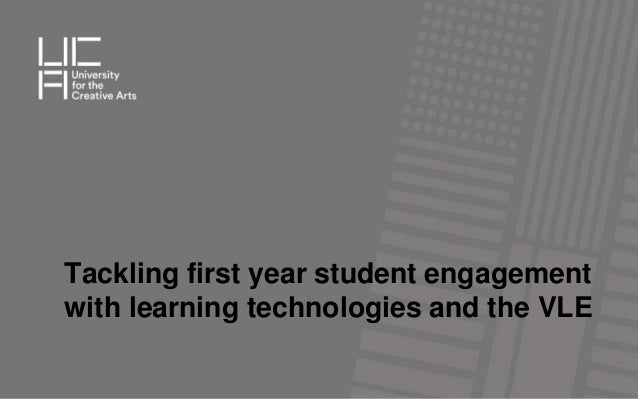-
Be the first to like this
-
Accelerating Sales - Marketing Less... by Chris Lema 16205 views
-
Succeed in Constant Change - Harnes... by KPMG US 1740 views
-
15 Differences Between Amateur & Pr... by Sadman Sadik 1951 views
-
We’re Leaking, and Everything’s Fin... by Ian McCarthy 1839 views
-
Business optimization | building yo... by Surjeet Singh 2042 views
-
4 Ways to Communicate Compensation ... by BambooHR 8234 views
Tackling first year student engagement with learning technologies and the VLE
-1
Maria Tannant
, Programme Manager in Digital PedagogyPublished on
This workshop addressed the importance of a Personal Learning Environment (PLE) and what guidance institutions provide to new students arriving to university with regard to using useful learning tools effectively. Workshop participants were made up of TEL expertise from across the HEI sector. Three groups of 5 or 6 people worked in 3 on the following tasks:
The Perfect PLE - Design a PLE to most enhance a new student's learning experience at university. The group may elect a specific subject area the student has chosen to study.
TEL Manifesto - Draft up an institutional TEL Manifesto intended for new students that enhances learning and enriches their online user experience.
The Padlet links (within the SlideShare) go to the online workspace the groups used during the session to collate discussion points and findings.
The conference in question was the 16th Durham Blackboard Users Conference 2016 – Learning from Failure held 6th, 7th & 8th January at Durham University.
The workshop session was delivered by Maria Tannant from the University for the Creative Arts.
You get a jolt of reality!
Who exactly is using the VLE and on what device
Namely the VLE
But we know this is far from possible.
- The ideal of a ‘central learning environment’ cannot be achieved anymore
- Like a pick and mix sweet shop, there’s a host of solutions
- Not everything is listed here, but these tools represent alternatives
- Catering for different learning styles
- A host of methods around digital curation… and digital literacy via resources and interaction
- These tools can offer greater flexibility and user experience for learning & teaching
How important and valuable are they to student learning?
After extensive testing here’s what I found worked on mobile and desktop devices
This course make it very clear to students how everyone is expected to communicate and what tools/platforms/resources they are to use throughout their time at Uni.
This includes social media such as LinkedIn, Twitter, Instagram and Pinterest.
However, the document does not cover the full extend of teaching and learning methods together with subject specific university resources.
So perhaps writing a T&L Strategy is the next task for the course team
Whereas laptops are employed for deeper study and the production of work
But this course’s adoption of the VLE is not mirrored across the university
Where there is contrasting uses of technology and processes
So perhaps we should be thinking more about exploiting the use of intuitive learning tools
- This was my own interpretation of the tools I used to enhance my learning
- But more importantly… how I organised my learning
- Getting onboard with Dropbox was the single biggest achievement to manage my study & work files
References
(1) Van Harmelen, H. (2008). "Design trajectories: four experiments in PLE implementation". Interactive Learning Environments 16 (1): 36 – 46.
http://www.tandfonline.com/doi/pdf/10.1080/10494820701772686
Specific tools have different uses depending on the user
The concept of being digitally organized has a large role to play for learners
And not bothering about adding to the basket of eggs in the VLE
The student could be viewed as the blindfolded chicken getting lost in the plethora of new technologies
Tackling first year student engagement with learning technologies and the VLE
- 1. Tackling first year student engagement with learning technologies and the VLE
- 2. All eggs in one basket… or just blindfold the chicken?
- 3. The ideal… all eggs in one basket
- 4. Scattered tools & resources used outside the VLE
- 5. what’s left in the VLE?
- 6. Default tools & resources in VLE
- 7. Students sampled for usage
- 8. Students sampled for VLE usage
- 9. PLEs are systems that help learners take control and manage their own learning (Harmelen 2008)
- 10. Diversity and usefulness
- 11. So who is the blindfolded chicken?
- 12. Is free-range any better?
- 13. Group Task 1 The Perfect PLE - 10 minutes Design a PLE to most enhance a new student's learning experience at university. The group may elect a specific subject area the student has chosen to study.
- 14. Group Task 2 TEL Manifesto - 10 minutes Draft up an institutional TEL Manifesto intended for new students that enhances learning and enriches their online user experience.
- 15. Group 1: http://padlet.com/mariatannant/BB1 Group 2: http://padlet.com/mariatannant/BB2 Group 3: http://padlet.com/mariatannant/BB3 Group Workspaces
- 16. MARIA TANNANT Programme Manager in Digital Pedagogy mtannant@uca.ac.uk References Van Harmelen, H. (2008). "Design trajectories: four experiments in PLE implementation". Interactive Learning Environments 16 (1): 36 – 46.
-
A particular slide catching your eye?
Clipping is a handy way to collect important slides you want to go back to later.








Be the first to comment